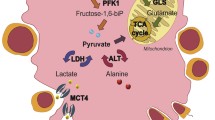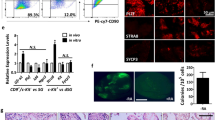Abstract
Apoptosis, necrosis and autophagy are mechanistically related processes that control tissue homeostasis and cell survival. In the testis, germ cell death is important for controlling sperm output, but it is unknown whether or not germ cells can switch from apoptosis to necrosis, as has been reported in other tissues. Furthermore, autophagy has not been reported in spermatogenesis. Spermatocytes (meiotic cells) and spermatids (haploid cells) use lactate rather than glucose as their primary substrate for producing ATP. The metabolism of glucose, but not lactate, reduces ATP levels and increases intracellular [H+] and [Ca2+], both of which are associated with apoptosis and/or necrosis in somatic cells. In this work, we evaluated whether different energy sources, such as lactate or glucose, can influence spermatocyte death type and/or survival in primary cultures. Spermatocytes cultured for 12 h without an energy source died by necrosis, while spermatocytes cultured with 5 mM glucose showed a significant increase in apoptosis, as evidenced by caspase activity, TUNEL assay and phosphatidylserine exposure. Apoptosis was not observed in spermatocytes cultured with 5 mM lactate or deoxyglucose. Authophagy markers, such as LC3-II and autophagosomes, were detected after 12 h of culture, regardless the culture conditions. These results suggest that the availability of glucose and/or lactate affect the type of death or the survival of primary spermatocytes, where glucose can induce apoptosis, while lactate is a protective factor.






Similar content being viewed by others
References
Feng HL, Sandlow JI, Sparks AE, Sandra A, Zheng LJ (1999) Decreased expression of the c-kit receptor is associated with increased apoptosis in subfertile human testes. Fertil Steril 71:85–89
Francavilla S, D’Abrizio P, Cordeschi G et al (2002) Fas expression correlates with human germ cell degeneration in meiotic and post-meiotic arrest of spermatogenesis. Mol Hum Reprod 8:213–220
Moreno RD, Urriola-Muñoz P, Lagos-Cabré R (2011) The emerging role of matrix metalloproteases of the ADAM family in male germ cell apoptosis. Spermatogenesis 1:195–208
Weikert S, Schrader M, Muller M, Schulze W, Krause H, Miller K (2005) Expression levels of the inhibitor of apoptosis survivin in testes of patients with normal spermatogenesis and spermatogenic failure. Fertil Steril 83(Suppl 1):1100–1105
Knudson CM, Tung KS, Tourtellotte WG, Brown GA, Korsmeyer SJ (1995) Bax-deficient mice with lymphoid hyperplasia and male germ cell death. Science 270:96–99
Bao Q, Shi Y (2007) Apoptosome: a platform for the activation of initiator caspases. Cell Death Differ 14:56–65
Degterev A, Yuan J (2008) Expansion and evolution of cell death programmes. Nat Rev Mol Cell Biol 9:378–390
Levine B, Klionsky DJ (2004) Development by self-digestion: molecular mechanisms and biological functions of autophagy. Dev Cell 6:463–477
Duriez PJ, Shah GM (1997) Cleavage of poly(ADP-ribose) polymerase: a sensitive parameter to study cell death. Biochem Cell Biol 75:337–349
Riedl SJ, Shi Y (2004) Molecular mechanisms of caspase regulation during apoptosis. Nat Rev Mol Cell Biol 5:897–907
Salvesen GS, Riedl SJ (2008) Caspase mechanisms. Adv Exp Med Biol 615:13–23
Galluzzi L, Maiuri MC, Vitale I et al (2007) Cell death modalities: classification and pathophysiological implications. Cell Death Differ 14:1237–1243
Golstein P, Kroemer G (2007) Cell death by necrosis: towards a molecular definition. Trends Biochem Sci 32:37–43
Wang AL, Boulton ME, Dunn WA Jr et al (2009) Using LC3 to monitor autophagy flux in the retinal pigment epithelium. Autophagy 5:1190–1193
Maiuri MC, Zalckvar E, Kimchi A, Kroemer G (2007) Self-eating and self-killing: crosstalk between autophagy and apoptosis. Nat Rev Mol Cell Biol 8:741–752
Harr MW, Distelhorst CW (2010) Apoptosis and autophagy: decoding calcium signals that mediate life or death. Cold Spring Harb Perspect Biol 2:a005579
Nakamura M, Fujiwara A, Yasumasu I, Okinaga S, Arai K (1982) Regulation of glucose metabolism by adenine nucleotides in round spermatids from rat testes. J Biol Chem 257:13945–13950
Nakamura M, Okinaga S, Arai K (1984) Metabolism of round spermatids: evidence that lactate is preferred substrate. Am J Physiol 247:E234–E242
Herrera E, Salas K, Lagos N, Benos DJ, Reyes JG (2000) Energy metabolism and its linkage to intracellular Ca2+ and pH regulation in rat spermatogenic cells. Biol Cell 92:429–440
Reyes JG, Herrera E, Lobos L et al (2002) Dynamics of intracellular calcium induced by lactate and glucose in rat pachytene spermatocytes and round spermatids. Reproduction 123:701–710
Chami M, Oules B, Szabadkai G, Tacine R, Rizzuto R, Paterlini-Brechot P (2008) Role of SERCA1 truncated isoform in the proapoptotic calcium transfer from ER to mitochondria during ER stress. Mol Cell 32:641–651
Lizama C, Alfaro I, Reyes JG, Moreno RD (2007) Up-regulation of CD95 (Apo-1/Fas) is associated with spermatocyte apoptosis during the first round of spermatogenesis in the rat. Apoptosis 12:499–512
Mishra DP, Pal R, Shaha C (2006) Changes in cytosolic Ca2+ levels regulate Bcl-xS and Bcl-xL expression in spermatogenic cells during apoptotic death. J Biol Chem 281:2133–2143
Pinton P, Giorgi C, Siviero R, Zecchini E, Rizzuto R (2008) Calcium and apoptosis: ER-mitochondria Ca2+ transfer in the control of apoptosis. Oncogene 27:6407–6418
Vicencio JM, Ortiz C, Criollo A et al (2009) The inositol 1,4,5-trisphosphate receptor regulates autophagy through its interaction with Beclin 1. Cell Death Differ 16:1006–1017
Wegierski T, Steffl D, Kopp C et al (2009) TRPP2 channels regulate apoptosis through the Ca2+ concentration in the endoplasmic reticulum. EMBO J 28:490–499
Moreno RD, Lizama C, Urzua N, Vergara SP, Reyes JG (2006) Caspase activation throughout the first wave of spermatogenesis in the rat. Cell Tissue Res 325:533–540
Van Pelt AM, De Rooij DG (1990) The origin of the synchronization of the seminiferous epithelium in vitamin A-deficient rats after vitamin A replacement. Biol Reprod 42:677–682
Reynolds ES (1963) The use of lead citrate at high pH as an electron-opaque stain in electron microscopy. J Cell Biol 17:208–212
Grynkiewicz G, Poenie M, Tsien RY (1985) A new generation of Ca2+ indicators with greatly improved fluorescence properties. J Biol Chem 260:3440–3450
Larsson D, Larsson B, Lundgren T, Sundell K (1999) The effect of pH and temperature on the dissociation constant for fura-2 and their effects on [Ca(2+)](i) in enterocytes from a poikilothermic animal, Atlantic cod (Gadus morhua). Anal Biochem 273:60–65
Zar JH (2009) Biostatiscal analysis. Prentice-Hall, Upper Saddle River
Wehrens XH, Lehnart SE, Marks AR (2005) Intracellular calcium release and cardiac disease. Annu Rev Physiol 67:69–98
Erkkila K, Aito H, Aalto K, Pentikainen V, Dunkel L (2002) Lactate inhibits germ cell apoptosis in the human testis. Mol Hum Reprod 8:109–117
Chandrasekaran K, Swaminathan K, Chatterjee S, Dey A (2009) Apoptosis in HepG2 cells exposed to high glucose. Toxicol In Vitro 24:387–396
Maedler K, Spinas GA, Lehmann R et al (2001) Glucose induces beta-cell apoptosis via upregulation of the Fas receptor in human islets. Diabetes 50:1683–1690
Santiago AR, Cristovao AJ, Santos PF, Carvalho CM, Ambrosio AF (2007) High glucose induces caspase-independent cell death in retinal neural cells. Neurobiol Dis 25:464–472
Bojunga J, Nowak D, Mitrou PS, Hoelzer D, Zeuzem S, Chow KU (2004) Antioxidative treatment prevents activation of death-receptor- and mitochondrion-dependent apoptosis in the hearts of diabetic rats. Diabetologia 47:2072–2080
Codelia VA, Cisternas P, Moreno RD (2008) Relevance of caspase activity during apoptosis in pubertal rat spermatogenesis. Mol Reprod Dev 75:881–889
Herceg Z, Wang ZQ (1999) Failure of poly(ADP-ribose) polymerase cleavage by caspases leads to induction of necrosis and enhanced apoptosis. Mol Cell Biol 19:5124–5133
Li L, Prevette D, Oppenheim RW, Milligan CE (1998) Involvement of specific caspases in motoneuron cell death in vivo and in vitro following trophic factor deprivation. Mol Cell Neurosci 12:157–167
Rodrigues P, Limback D, McGinnis LK, Plancha CE, Albertini DF (2009) Multiple mechanisms of germ cell loss in the perinatal mouse ovary. Reproduction 137:709–720
Pizzo P, Pozzan T (2007) Mitochondria-endoplasmic reticulum choreography: structure and signaling dynamics. Trends Cell Biol 17:511–517
Hinton BT, Howards SS (1982) Rat testis and epididymis can transport [3H] 3-O-methyl-d-glucose, [3H] inositol and [3H] alpha-aminoisobutyric acid across its epithelia in vivo. Biol Reprod 27:1181–1189
Mita M, Hall PF (1982) Metabolism of round spermatids from rats: lactate as the preferred substrate. Biol Reprod 26:445–455
Mita M, Price JM, Hall PF (1982) Stimulation by follicle-stimulating hormone of synthesis of lactate by Sertoli cells from rat testis. Endocrinology 110:1535–1541
Morales A, Mohamed F, Cavicchia JC (2007) Apoptosis and blood-testis barrier during the first spermatogenic wave in the pubertal rat. Anat Rec (Hoboken) 290:206–214
Silva D, Lizama C, Tapia V, Moreno RD (2011) Propylthiouracil-induced hypothyroidism delays apoptosis during the first wave of spermatogenesis. Biol Res 44:181–188
Pareek TK, Joshi AR, Sanyal A, Dighe RR (2007) Insights into male germ cell apoptosis due to depletion of gonadotropins caused by GnRH antagonists. Apoptosis 12:1085–1100
Billig H, Furuta I, Rivier C, Tapanainen J, Parvinen M, Hsueh AJ (1995) Apoptosis in testis germ cells: developmental changes in gonadotropin dependence and localization to selective tubule stages. Endocrinology 136:5–12
Acknowledgments
Part of this work was supported by a grant from the Chilean Research Council (FONDECYT, 1110778 and 1110267) to RDM and JGR and FONDAP 15010006 to SL.
Conflict of interest
None declared.
Author information
Authors and Affiliations
Corresponding author
Electronic supplementary material
Below is the link to the electronic supplementary material.
Rights and permissions
About this article
Cite this article
Bustamante-Marín, X., Quiroga, C., Lavandero, S. et al. Apoptosis, necrosis and autophagy are influenced by metabolic energy sources in cultured rat spermatocytes. Apoptosis 17, 539–550 (2012). https://doi.org/10.1007/s10495-012-0709-2
Published:
Issue Date:
DOI: https://doi.org/10.1007/s10495-012-0709-2




